UNI Library System Analysis: Project Report, [University Name]
VerifiedAdded on 2021/05/31
|26
|3070
|47
Project
AI Summary
This document presents a thorough analysis of the UNI library information system. It begins with project planning, including a Gantt chart and Trello board, followed by detailed requirements documentation. The core of the analysis includes a use case diagram, textual use case descriptions, a sequence diagram illustrating user interactions, and a class diagram representing the system's structure. The project also features an activity diagram and user interface designs for various functionalities such as login, loans, and member management. Finally, the document includes test case generation and a conclusion summarizing the findings. This comprehensive project aims to provide a complete overview of the library system's design and operation, serving as a valuable resource for understanding information system analysis.
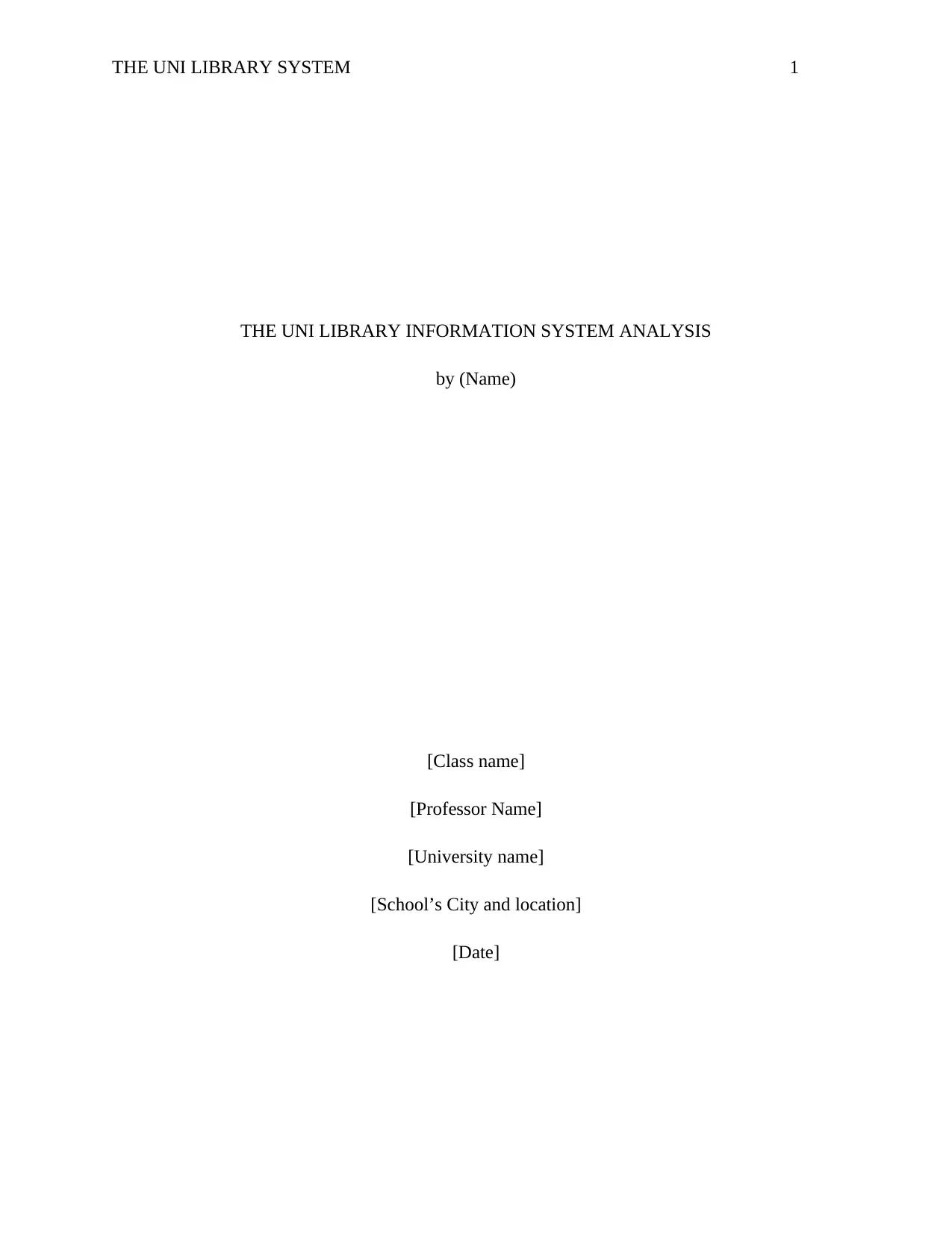
THE UNI LIBRARY SYSTEM 1
THE UNI LIBRARY INFORMATION SYSTEM ANALYSIS
by (Name)
[Class name]
[Professor Name]
[University name]
[School’s City and location]
[Date]
THE UNI LIBRARY INFORMATION SYSTEM ANALYSIS
by (Name)
[Class name]
[Professor Name]
[University name]
[School’s City and location]
[Date]
Paraphrase This Document
Need a fresh take? Get an instant paraphrase of this document with our AI Paraphraser
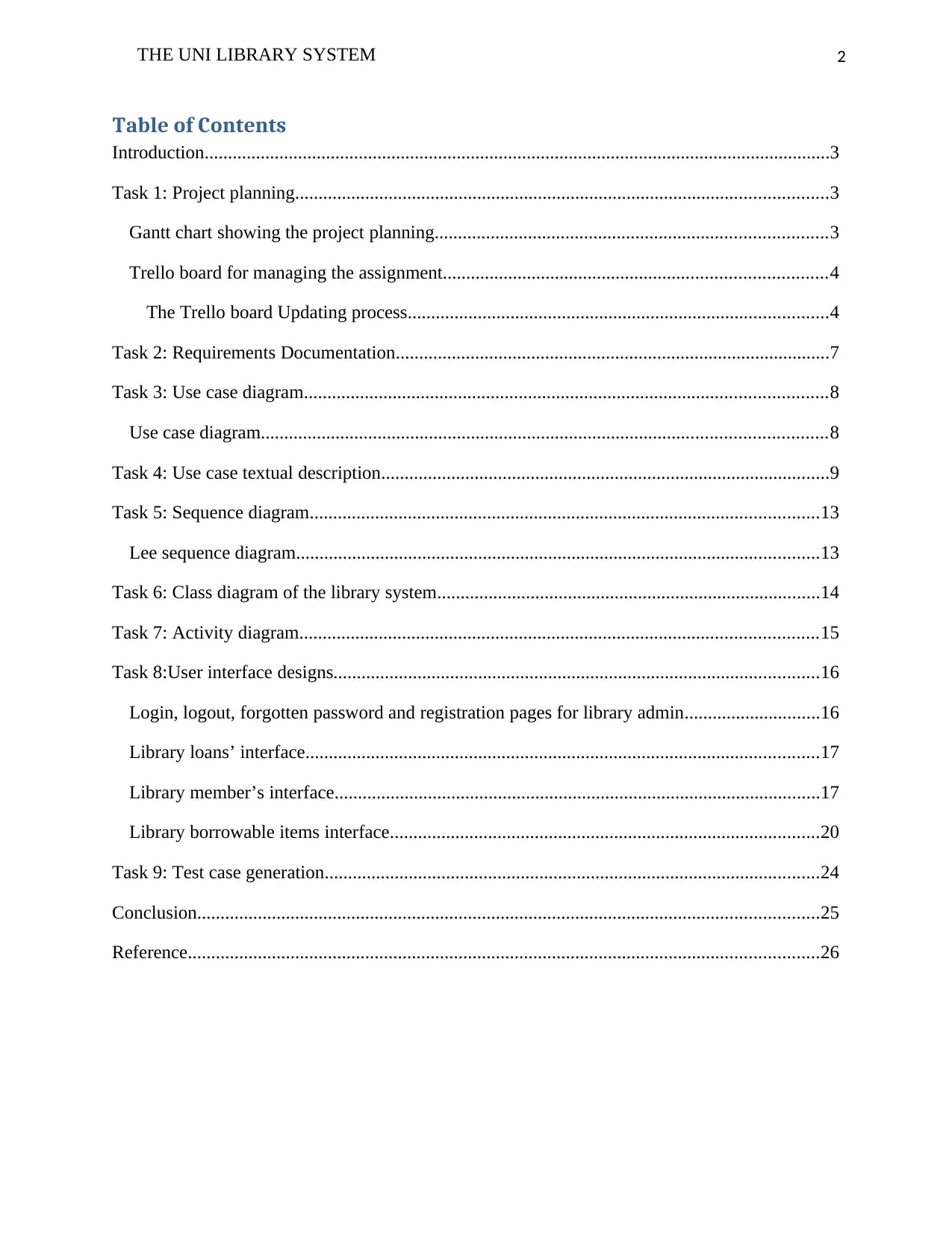
2THE UNI LIBRARY SYSTEM
Table of Contents
Introduction......................................................................................................................................3
Task 1: Project planning..................................................................................................................3
Gantt chart showing the project planning....................................................................................3
Trello board for managing the assignment..................................................................................4
The Trello board Updating process..........................................................................................4
Task 2: Requirements Documentation.............................................................................................7
Task 3: Use case diagram................................................................................................................8
Use case diagram.........................................................................................................................8
Task 4: Use case textual description................................................................................................9
Task 5: Sequence diagram.............................................................................................................13
Lee sequence diagram................................................................................................................13
Task 6: Class diagram of the library system..................................................................................14
Task 7: Activity diagram...............................................................................................................15
Task 8:User interface designs........................................................................................................16
Login, logout, forgotten password and registration pages for library admin.............................16
Library loans’ interface..............................................................................................................17
Library member’s interface........................................................................................................17
Library borrowable items interface............................................................................................20
Task 9: Test case generation..........................................................................................................24
Conclusion.....................................................................................................................................25
Reference.......................................................................................................................................26
Table of Contents
Introduction......................................................................................................................................3
Task 1: Project planning..................................................................................................................3
Gantt chart showing the project planning....................................................................................3
Trello board for managing the assignment..................................................................................4
The Trello board Updating process..........................................................................................4
Task 2: Requirements Documentation.............................................................................................7
Task 3: Use case diagram................................................................................................................8
Use case diagram.........................................................................................................................8
Task 4: Use case textual description................................................................................................9
Task 5: Sequence diagram.............................................................................................................13
Lee sequence diagram................................................................................................................13
Task 6: Class diagram of the library system..................................................................................14
Task 7: Activity diagram...............................................................................................................15
Task 8:User interface designs........................................................................................................16
Login, logout, forgotten password and registration pages for library admin.............................16
Library loans’ interface..............................................................................................................17
Library member’s interface........................................................................................................17
Library borrowable items interface............................................................................................20
Task 9: Test case generation..........................................................................................................24
Conclusion.....................................................................................................................................25
Reference.......................................................................................................................................26
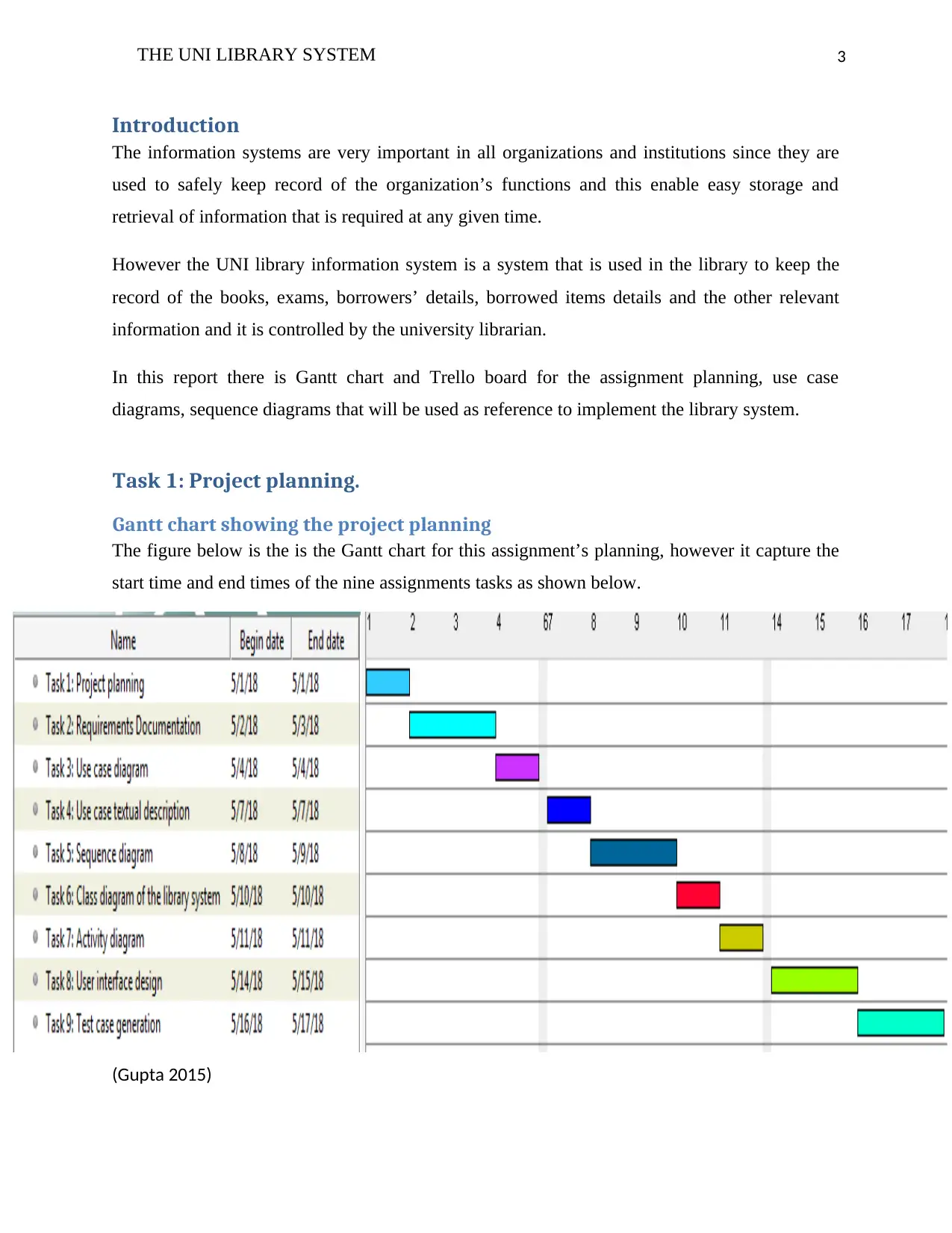
3THE UNI LIBRARY SYSTEM
Introduction
The information systems are very important in all organizations and institutions since they are
used to safely keep record of the organization’s functions and this enable easy storage and
retrieval of information that is required at any given time.
However the UNI library information system is a system that is used in the library to keep the
record of the books, exams, borrowers’ details, borrowed items details and the other relevant
information and it is controlled by the university librarian.
In this report there is Gantt chart and Trello board for the assignment planning, use case
diagrams, sequence diagrams that will be used as reference to implement the library system.
Task 1: Project planning.
Gantt chart showing the project planning
The figure below is the is the Gantt chart for this assignment’s planning, however it capture the
start time and end times of the nine assignments tasks as shown below.
(Gupta 2015)
Introduction
The information systems are very important in all organizations and institutions since they are
used to safely keep record of the organization’s functions and this enable easy storage and
retrieval of information that is required at any given time.
However the UNI library information system is a system that is used in the library to keep the
record of the books, exams, borrowers’ details, borrowed items details and the other relevant
information and it is controlled by the university librarian.
In this report there is Gantt chart and Trello board for the assignment planning, use case
diagrams, sequence diagrams that will be used as reference to implement the library system.
Task 1: Project planning.
Gantt chart showing the project planning
The figure below is the is the Gantt chart for this assignment’s planning, however it capture the
start time and end times of the nine assignments tasks as shown below.
(Gupta 2015)
⊘ This is a preview!⊘
Do you want full access?
Subscribe today to unlock all pages.

Trusted by 1+ million students worldwide
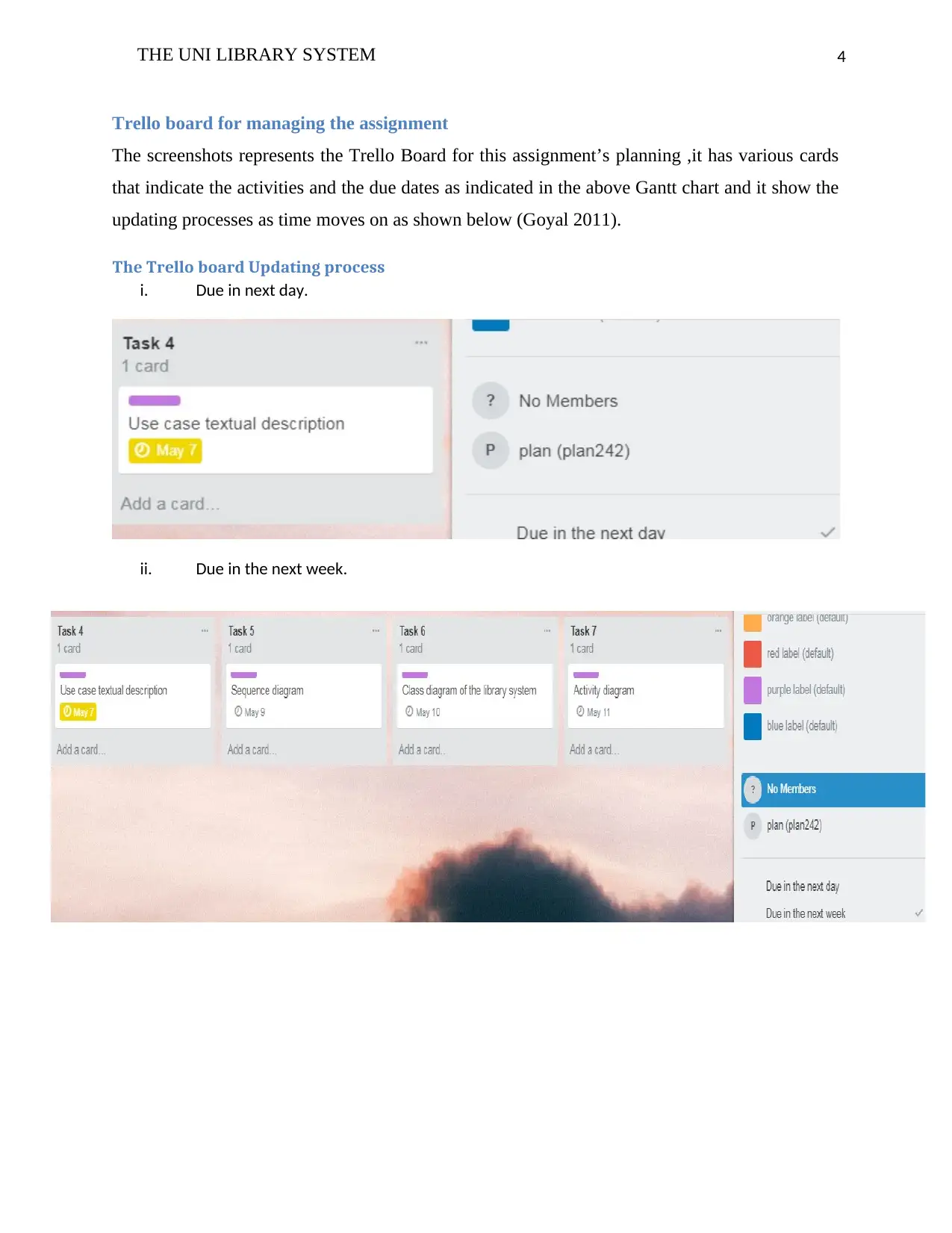
4THE UNI LIBRARY SYSTEM
Trello board for managing the assignment
The screenshots represents the Trello Board for this assignment’s planning ,it has various cards
that indicate the activities and the due dates as indicated in the above Gantt chart and it show the
updating processes as time moves on as shown below (Goyal 2011).
The Trello board Updating process
i. Due in next day.
ii. Due in the next week.
Trello board for managing the assignment
The screenshots represents the Trello Board for this assignment’s planning ,it has various cards
that indicate the activities and the due dates as indicated in the above Gantt chart and it show the
updating processes as time moves on as shown below (Goyal 2011).
The Trello board Updating process
i. Due in next day.
ii. Due in the next week.
Paraphrase This Document
Need a fresh take? Get an instant paraphrase of this document with our AI Paraphraser
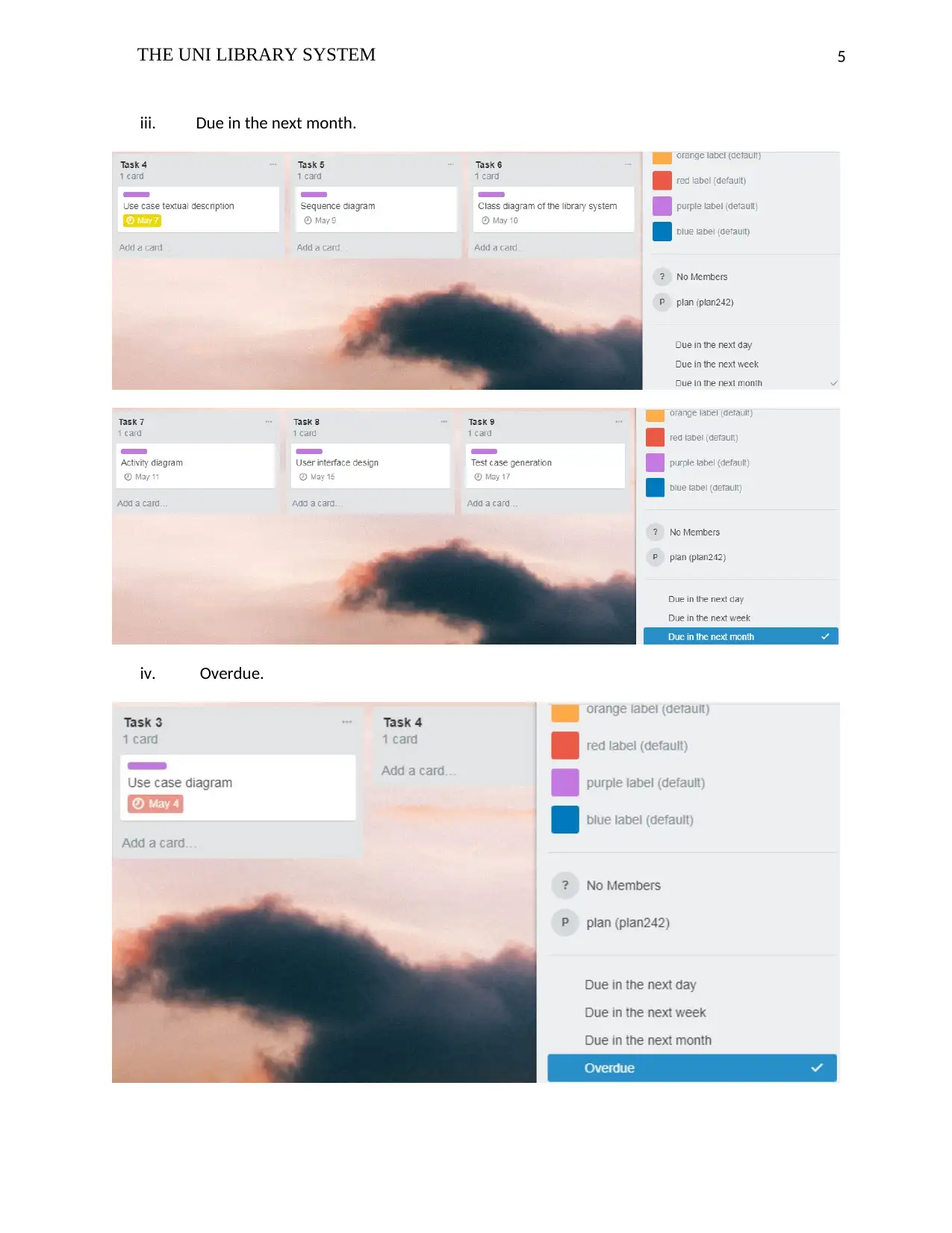
5THE UNI LIBRARY SYSTEM
iii. Due in the next month.
iv. Overdue.
iii. Due in the next month.
iv. Overdue.
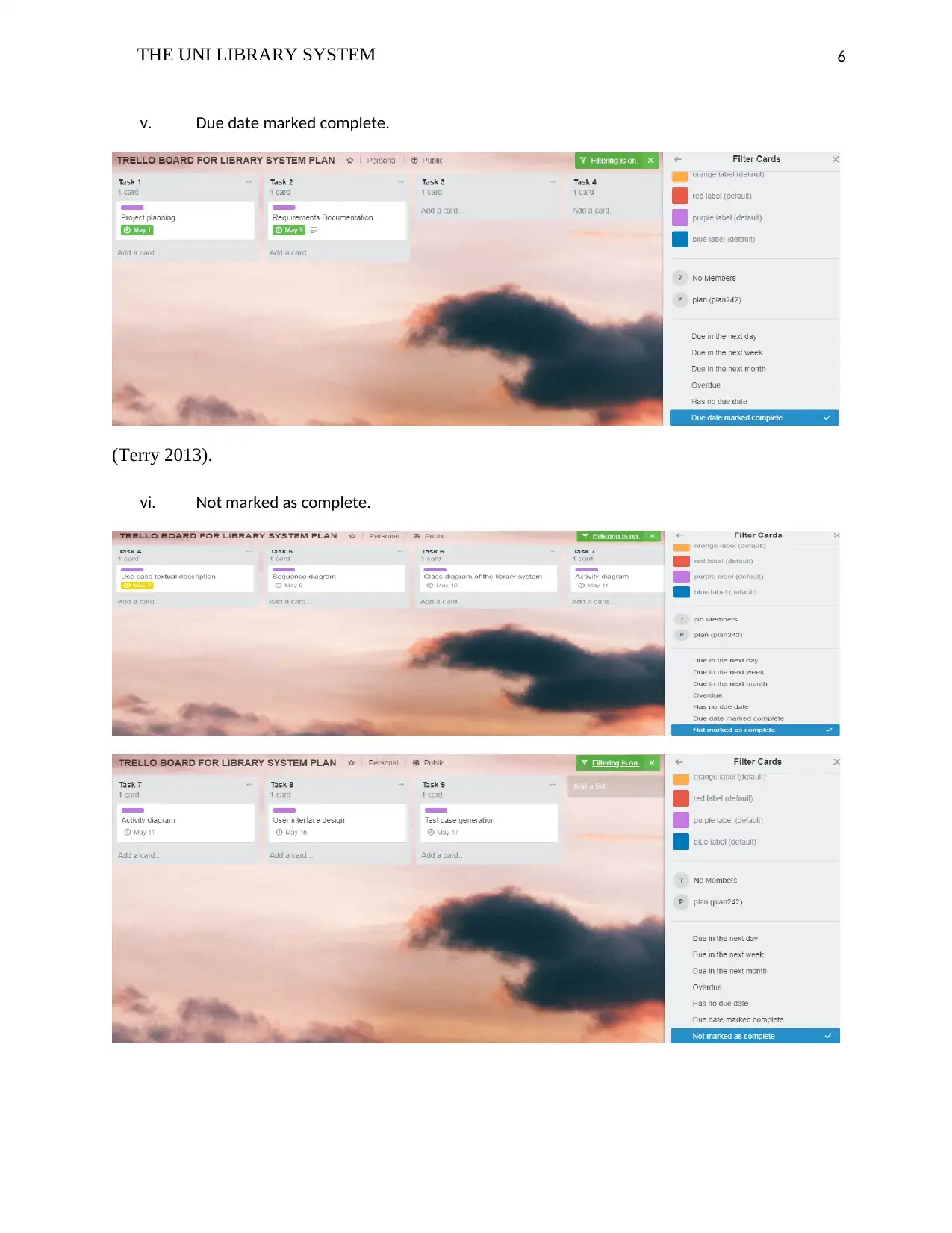
6THE UNI LIBRARY SYSTEM
v. Due date marked complete.
(Terry 2013).
vi. Not marked as complete.
v. Due date marked complete.
(Terry 2013).
vi. Not marked as complete.
⊘ This is a preview!⊘
Do you want full access?
Subscribe today to unlock all pages.

Trusted by 1+ million students worldwide
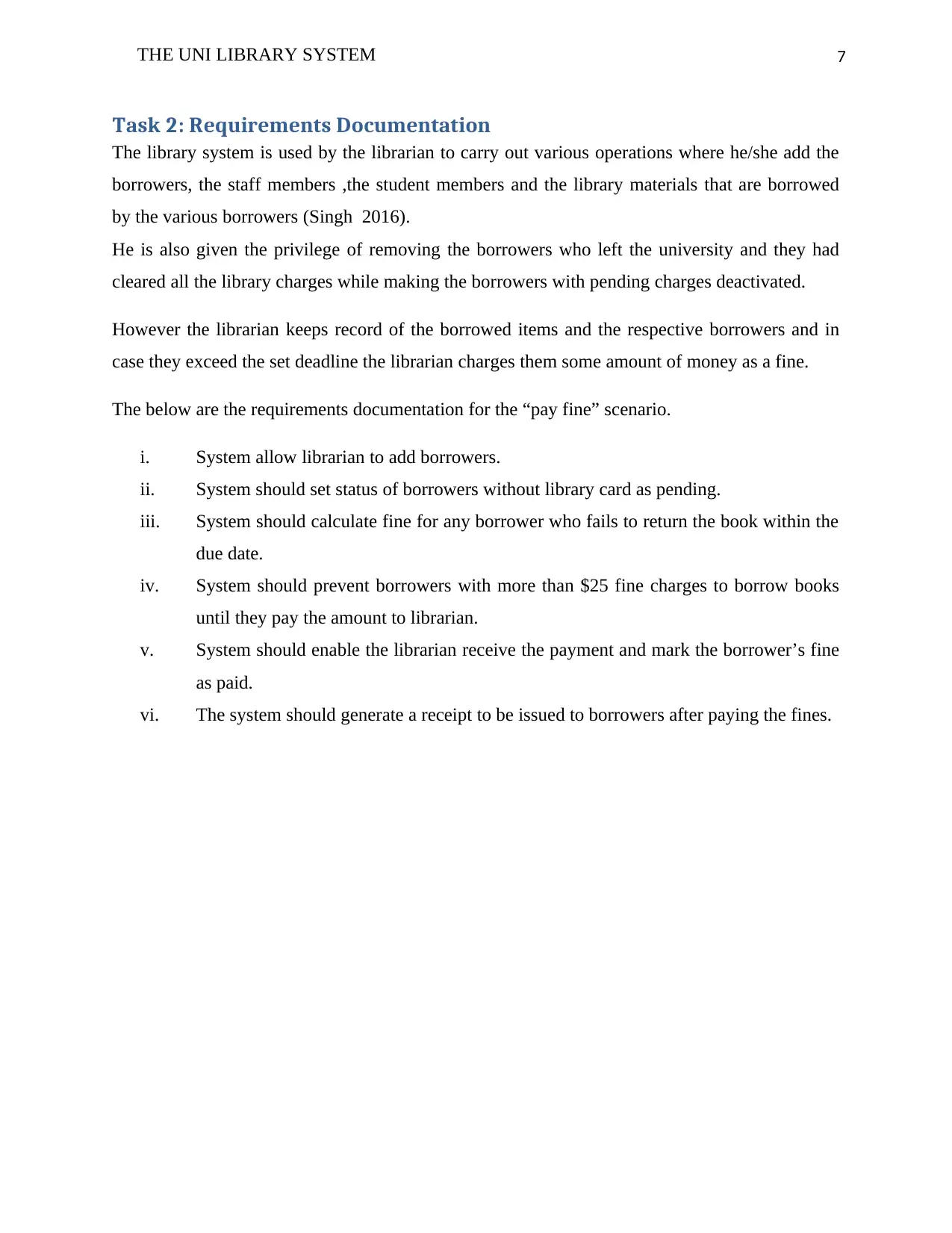
7THE UNI LIBRARY SYSTEM
Task 2: Requirements Documentation
The library system is used by the librarian to carry out various operations where he/she add the
borrowers, the staff members ,the student members and the library materials that are borrowed
by the various borrowers (Singh 2016).
He is also given the privilege of removing the borrowers who left the university and they had
cleared all the library charges while making the borrowers with pending charges deactivated.
However the librarian keeps record of the borrowed items and the respective borrowers and in
case they exceed the set deadline the librarian charges them some amount of money as a fine.
The below are the requirements documentation for the “pay fine” scenario.
i. System allow librarian to add borrowers.
ii. System should set status of borrowers without library card as pending.
iii. System should calculate fine for any borrower who fails to return the book within the
due date.
iv. System should prevent borrowers with more than $25 fine charges to borrow books
until they pay the amount to librarian.
v. System should enable the librarian receive the payment and mark the borrower’s fine
as paid.
vi. The system should generate a receipt to be issued to borrowers after paying the fines.
Task 2: Requirements Documentation
The library system is used by the librarian to carry out various operations where he/she add the
borrowers, the staff members ,the student members and the library materials that are borrowed
by the various borrowers (Singh 2016).
He is also given the privilege of removing the borrowers who left the university and they had
cleared all the library charges while making the borrowers with pending charges deactivated.
However the librarian keeps record of the borrowed items and the respective borrowers and in
case they exceed the set deadline the librarian charges them some amount of money as a fine.
The below are the requirements documentation for the “pay fine” scenario.
i. System allow librarian to add borrowers.
ii. System should set status of borrowers without library card as pending.
iii. System should calculate fine for any borrower who fails to return the book within the
due date.
iv. System should prevent borrowers with more than $25 fine charges to borrow books
until they pay the amount to librarian.
v. System should enable the librarian receive the payment and mark the borrower’s fine
as paid.
vi. The system should generate a receipt to be issued to borrowers after paying the fines.
Paraphrase This Document
Need a fresh take? Get an instant paraphrase of this document with our AI Paraphraser
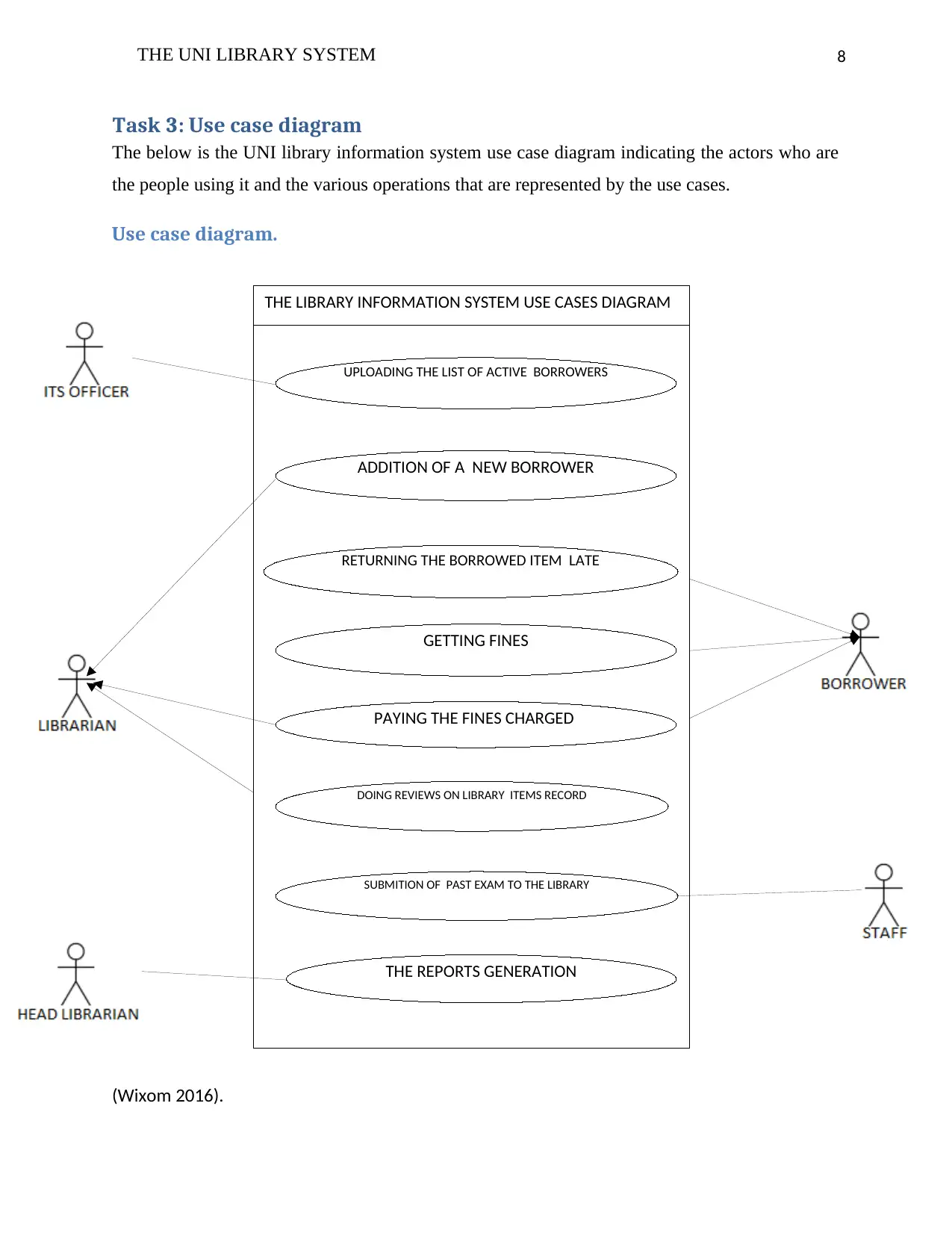
8THE UNI LIBRARY SYSTEM
THE LIBRARY INFORMATION SYSTEM USE CASES DIAGRAM
UPLOADING THE LIST OF ACTIVE BORROWERS
ADDITION OF A NEW BORROWER
RETURNING THE BORROWED ITEM LATE
GETTING FINES
PAYING THE FINES CHARGED
DOING REVIEWS ON LIBRARY ITEMS RECORD
SUBMITION OF PAST EXAM TO THE LIBRARY
THE REPORTS GENERATION
Task 3: Use case diagram
The below is the UNI library information system use case diagram indicating the actors who are
the people using it and the various operations that are represented by the use cases.
Use case diagram.
(Wixom 2016).
THE LIBRARY INFORMATION SYSTEM USE CASES DIAGRAM
UPLOADING THE LIST OF ACTIVE BORROWERS
ADDITION OF A NEW BORROWER
RETURNING THE BORROWED ITEM LATE
GETTING FINES
PAYING THE FINES CHARGED
DOING REVIEWS ON LIBRARY ITEMS RECORD
SUBMITION OF PAST EXAM TO THE LIBRARY
THE REPORTS GENERATION
Task 3: Use case diagram
The below is the UNI library information system use case diagram indicating the actors who are
the people using it and the various operations that are represented by the use cases.
Use case diagram.
(Wixom 2016).
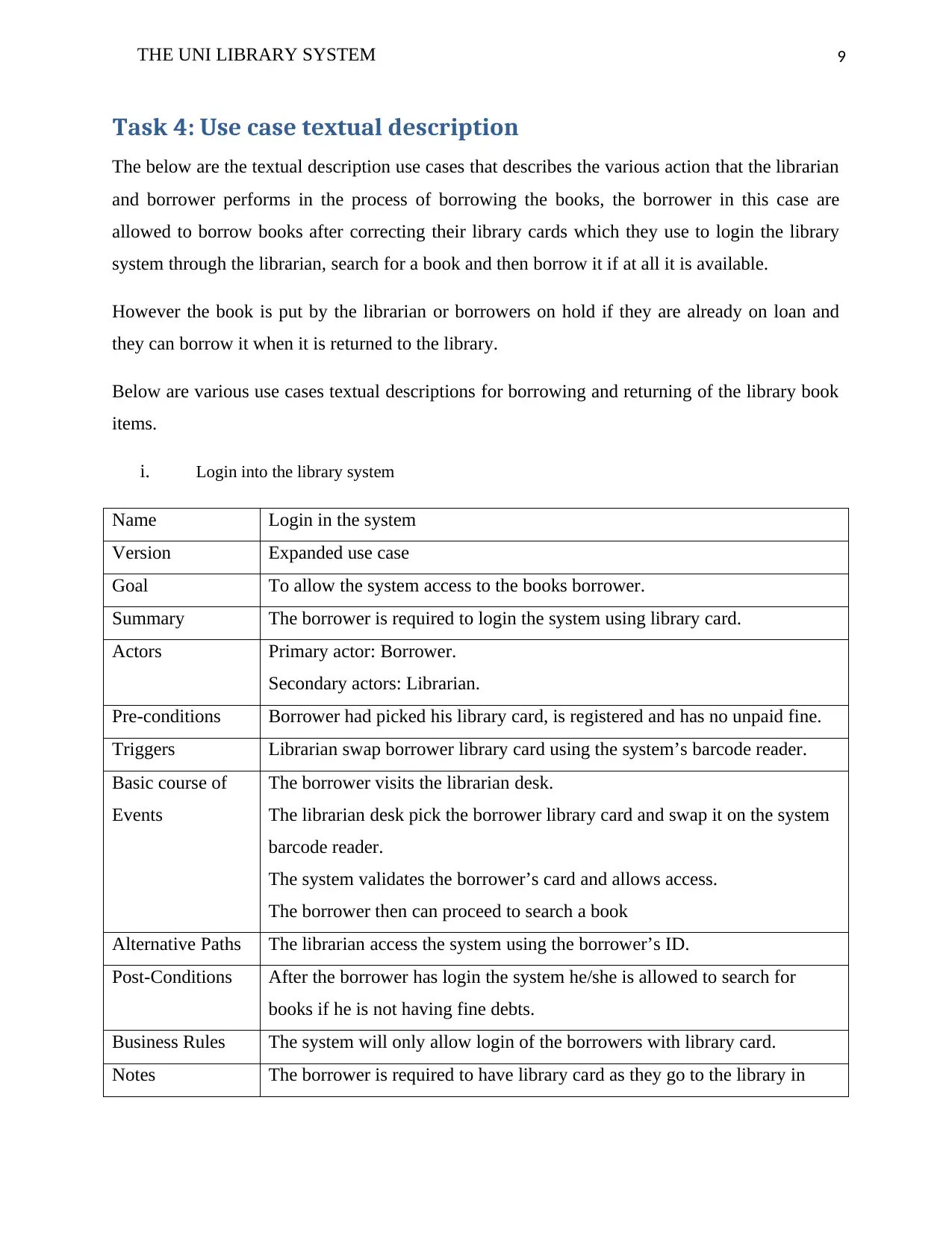
9THE UNI LIBRARY SYSTEM
Task 4: Use case textual description
The below are the textual description use cases that describes the various action that the librarian
and borrower performs in the process of borrowing the books, the borrower in this case are
allowed to borrow books after correcting their library cards which they use to login the library
system through the librarian, search for a book and then borrow it if at all it is available.
However the book is put by the librarian or borrowers on hold if they are already on loan and
they can borrow it when it is returned to the library.
Below are various use cases textual descriptions for borrowing and returning of the library book
items.
i. Login into the library system
Name Login in the system
Version Expanded use case
Goal To allow the system access to the books borrower.
Summary The borrower is required to login the system using library card.
Actors Primary actor: Borrower.
Secondary actors: Librarian.
Pre-conditions Borrower had picked his library card, is registered and has no unpaid fine.
Triggers Librarian swap borrower library card using the system’s barcode reader.
Basic course of
Events
The borrower visits the librarian desk.
The librarian desk pick the borrower library card and swap it on the system
barcode reader.
The system validates the borrower’s card and allows access.
The borrower then can proceed to search a book
Alternative Paths The librarian access the system using the borrower’s ID.
Post-Conditions After the borrower has login the system he/she is allowed to search for
books if he is not having fine debts.
Business Rules The system will only allow login of the borrowers with library card.
Notes The borrower is required to have library card as they go to the library in
Task 4: Use case textual description
The below are the textual description use cases that describes the various action that the librarian
and borrower performs in the process of borrowing the books, the borrower in this case are
allowed to borrow books after correcting their library cards which they use to login the library
system through the librarian, search for a book and then borrow it if at all it is available.
However the book is put by the librarian or borrowers on hold if they are already on loan and
they can borrow it when it is returned to the library.
Below are various use cases textual descriptions for borrowing and returning of the library book
items.
i. Login into the library system
Name Login in the system
Version Expanded use case
Goal To allow the system access to the books borrower.
Summary The borrower is required to login the system using library card.
Actors Primary actor: Borrower.
Secondary actors: Librarian.
Pre-conditions Borrower had picked his library card, is registered and has no unpaid fine.
Triggers Librarian swap borrower library card using the system’s barcode reader.
Basic course of
Events
The borrower visits the librarian desk.
The librarian desk pick the borrower library card and swap it on the system
barcode reader.
The system validates the borrower’s card and allows access.
The borrower then can proceed to search a book
Alternative Paths The librarian access the system using the borrower’s ID.
Post-Conditions After the borrower has login the system he/she is allowed to search for
books if he is not having fine debts.
Business Rules The system will only allow login of the borrowers with library card.
Notes The borrower is required to have library card as they go to the library in
⊘ This is a preview!⊘
Do you want full access?
Subscribe today to unlock all pages.

Trusted by 1+ million students worldwide
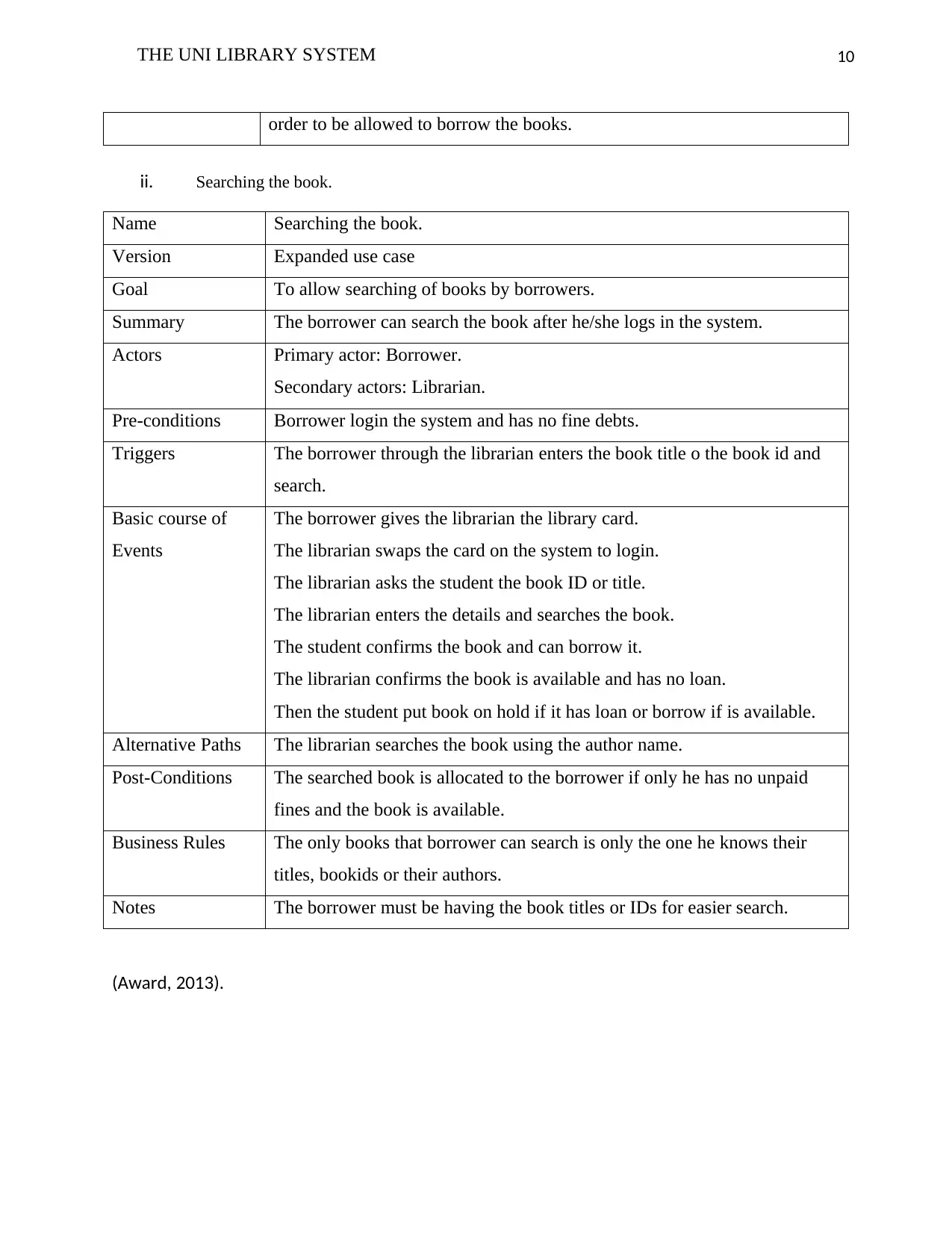
10THE UNI LIBRARY SYSTEM
order to be allowed to borrow the books.
ii. Searching the book.
Name Searching the book.
Version Expanded use case
Goal To allow searching of books by borrowers.
Summary The borrower can search the book after he/she logs in the system.
Actors Primary actor: Borrower.
Secondary actors: Librarian.
Pre-conditions Borrower login the system and has no fine debts.
Triggers The borrower through the librarian enters the book title o the book id and
search.
Basic course of
Events
The borrower gives the librarian the library card.
The librarian swaps the card on the system to login.
The librarian asks the student the book ID or title.
The librarian enters the details and searches the book.
The student confirms the book and can borrow it.
The librarian confirms the book is available and has no loan.
Then the student put book on hold if it has loan or borrow if is available.
Alternative Paths The librarian searches the book using the author name.
Post-Conditions The searched book is allocated to the borrower if only he has no unpaid
fines and the book is available.
Business Rules The only books that borrower can search is only the one he knows their
titles, bookids or their authors.
Notes The borrower must be having the book titles or IDs for easier search.
(Award, 2013).
order to be allowed to borrow the books.
ii. Searching the book.
Name Searching the book.
Version Expanded use case
Goal To allow searching of books by borrowers.
Summary The borrower can search the book after he/she logs in the system.
Actors Primary actor: Borrower.
Secondary actors: Librarian.
Pre-conditions Borrower login the system and has no fine debts.
Triggers The borrower through the librarian enters the book title o the book id and
search.
Basic course of
Events
The borrower gives the librarian the library card.
The librarian swaps the card on the system to login.
The librarian asks the student the book ID or title.
The librarian enters the details and searches the book.
The student confirms the book and can borrow it.
The librarian confirms the book is available and has no loan.
Then the student put book on hold if it has loan or borrow if is available.
Alternative Paths The librarian searches the book using the author name.
Post-Conditions The searched book is allocated to the borrower if only he has no unpaid
fines and the book is available.
Business Rules The only books that borrower can search is only the one he knows their
titles, bookids or their authors.
Notes The borrower must be having the book titles or IDs for easier search.
(Award, 2013).
Paraphrase This Document
Need a fresh take? Get an instant paraphrase of this document with our AI Paraphraser
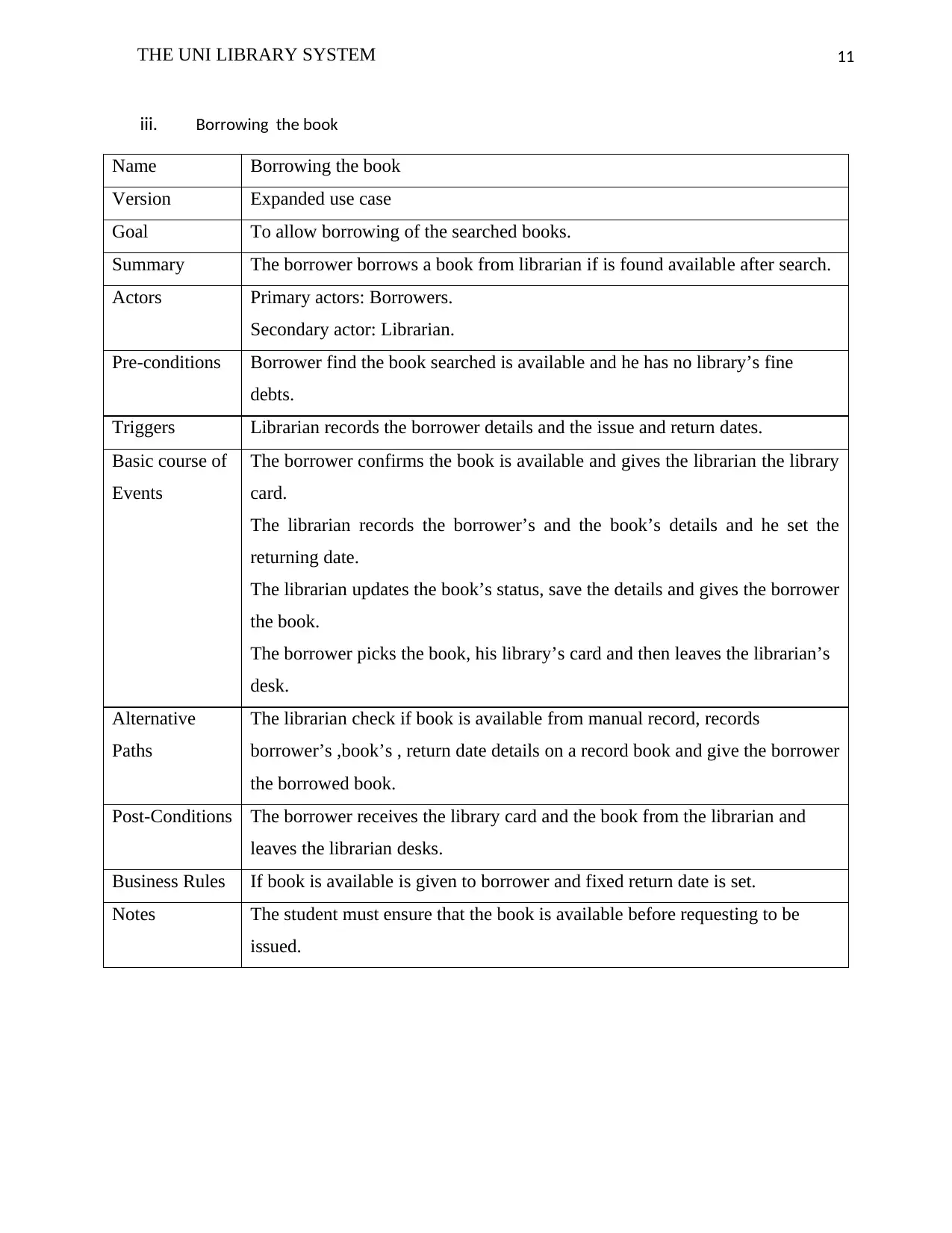
11THE UNI LIBRARY SYSTEM
iii. Borrowing the book
Name Borrowing the book
Version Expanded use case
Goal To allow borrowing of the searched books.
Summary The borrower borrows a book from librarian if is found available after search.
Actors Primary actors: Borrowers.
Secondary actor: Librarian.
Pre-conditions Borrower find the book searched is available and he has no library’s fine
debts.
Triggers Librarian records the borrower details and the issue and return dates.
Basic course of
Events
The borrower confirms the book is available and gives the librarian the library
card.
The librarian records the borrower’s and the book’s details and he set the
returning date.
The librarian updates the book’s status, save the details and gives the borrower
the book.
The borrower picks the book, his library’s card and then leaves the librarian’s
desk.
Alternative
Paths
The librarian check if book is available from manual record, records
borrower’s ,book’s , return date details on a record book and give the borrower
the borrowed book.
Post-Conditions The borrower receives the library card and the book from the librarian and
leaves the librarian desks.
Business Rules If book is available is given to borrower and fixed return date is set.
Notes The student must ensure that the book is available before requesting to be
issued.
iii. Borrowing the book
Name Borrowing the book
Version Expanded use case
Goal To allow borrowing of the searched books.
Summary The borrower borrows a book from librarian if is found available after search.
Actors Primary actors: Borrowers.
Secondary actor: Librarian.
Pre-conditions Borrower find the book searched is available and he has no library’s fine
debts.
Triggers Librarian records the borrower details and the issue and return dates.
Basic course of
Events
The borrower confirms the book is available and gives the librarian the library
card.
The librarian records the borrower’s and the book’s details and he set the
returning date.
The librarian updates the book’s status, save the details and gives the borrower
the book.
The borrower picks the book, his library’s card and then leaves the librarian’s
desk.
Alternative
Paths
The librarian check if book is available from manual record, records
borrower’s ,book’s , return date details on a record book and give the borrower
the borrowed book.
Post-Conditions The borrower receives the library card and the book from the librarian and
leaves the librarian desks.
Business Rules If book is available is given to borrower and fixed return date is set.
Notes The student must ensure that the book is available before requesting to be
issued.
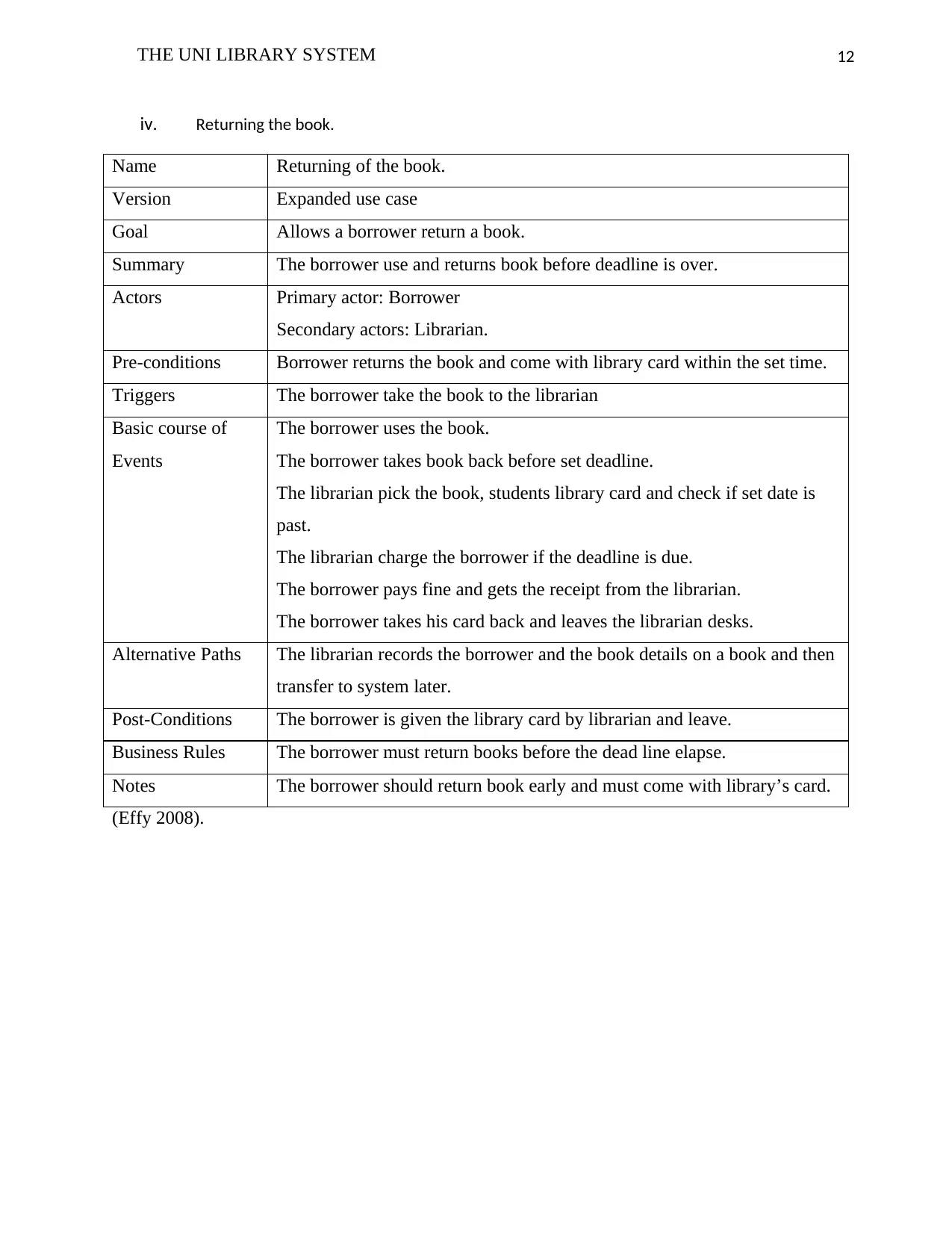
12THE UNI LIBRARY SYSTEM
iv. Returning the book.
Name Returning of the book.
Version Expanded use case
Goal Allows a borrower return a book.
Summary The borrower use and returns book before deadline is over.
Actors Primary actor: Borrower
Secondary actors: Librarian.
Pre-conditions Borrower returns the book and come with library card within the set time.
Triggers The borrower take the book to the librarian
Basic course of
Events
The borrower uses the book.
The borrower takes book back before set deadline.
The librarian pick the book, students library card and check if set date is
past.
The librarian charge the borrower if the deadline is due.
The borrower pays fine and gets the receipt from the librarian.
The borrower takes his card back and leaves the librarian desks.
Alternative Paths The librarian records the borrower and the book details on a book and then
transfer to system later.
Post-Conditions The borrower is given the library card by librarian and leave.
Business Rules The borrower must return books before the dead line elapse.
Notes The borrower should return book early and must come with library’s card.
(Effy 2008).
iv. Returning the book.
Name Returning of the book.
Version Expanded use case
Goal Allows a borrower return a book.
Summary The borrower use and returns book before deadline is over.
Actors Primary actor: Borrower
Secondary actors: Librarian.
Pre-conditions Borrower returns the book and come with library card within the set time.
Triggers The borrower take the book to the librarian
Basic course of
Events
The borrower uses the book.
The borrower takes book back before set deadline.
The librarian pick the book, students library card and check if set date is
past.
The librarian charge the borrower if the deadline is due.
The borrower pays fine and gets the receipt from the librarian.
The borrower takes his card back and leaves the librarian desks.
Alternative Paths The librarian records the borrower and the book details on a book and then
transfer to system later.
Post-Conditions The borrower is given the library card by librarian and leave.
Business Rules The borrower must return books before the dead line elapse.
Notes The borrower should return book early and must come with library’s card.
(Effy 2008).
⊘ This is a preview!⊘
Do you want full access?
Subscribe today to unlock all pages.

Trusted by 1+ million students worldwide
1 out of 26
Related Documents
Your All-in-One AI-Powered Toolkit for Academic Success.
+13062052269
info@desklib.com
Available 24*7 on WhatsApp / Email
![[object Object]](/_next/static/media/star-bottom.7253800d.svg)
Unlock your academic potential
Copyright © 2020–2025 A2Z Services. All Rights Reserved. Developed and managed by ZUCOL.





